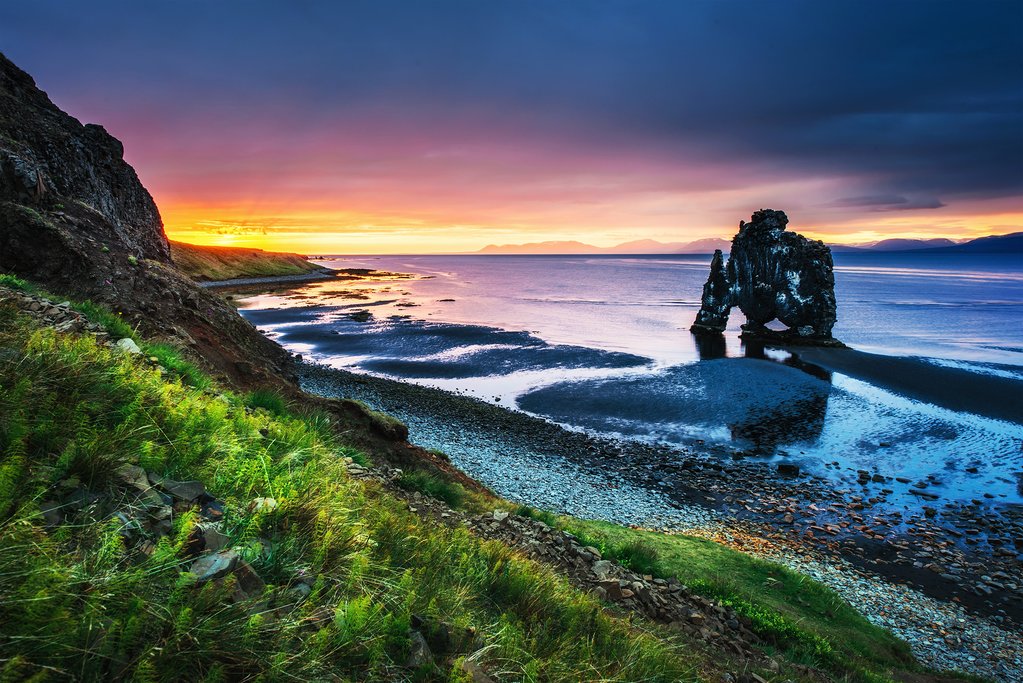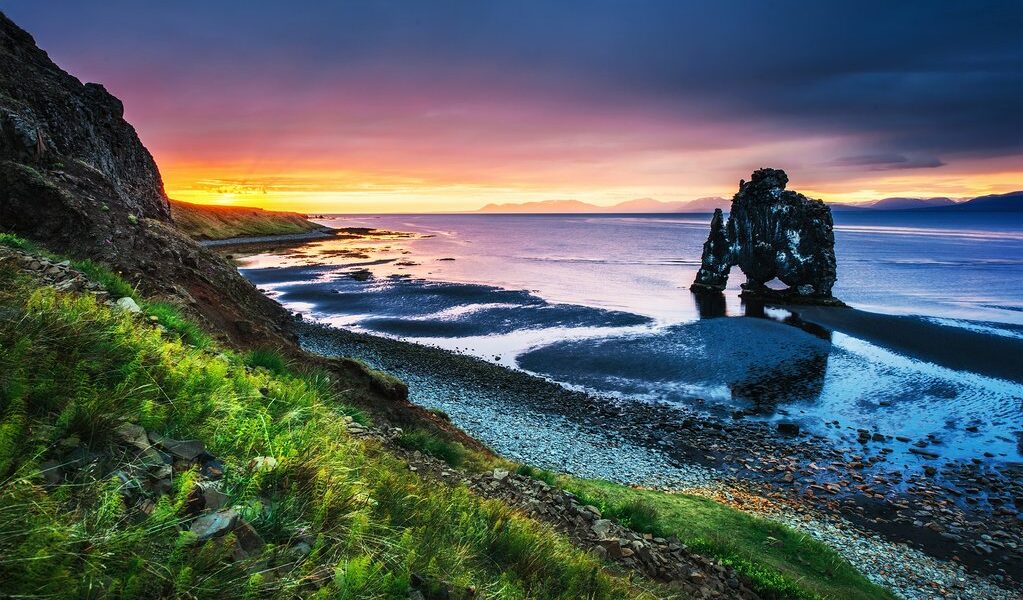
July is high season for Iceland where you can expect the country’s best weather, a lively vibe from locals who spend as much time outside as possible, and loads of fun events. Read this monthly guide to learn more (and how to beat the inevitable crowds).
July in Iceland: A Comprehensive Guide to the Land of Fire and Ice During Peak Season
Iceland, a land of dramatic landscapes and ethereal beauty, beckons travelers from across the globe. And when it comes to experiencing the magic of this Nordic nation, July emerges as a prime time to visit. With milder weather, extended daylight hours, and a vibrant atmosphere, Iceland in July offers an array of adventures and unforgettable moments. However, it’s essential to be well-prepared for the unique conditions and increased popularity of this time of year.
Weather in July: Embracing Iceland’s Summer Climate
July stands out as Iceland’s warmest month, offering the most favorable weather conditions for exploration. Rainfall is at its lowest, making it an ideal time for outdoor activities and road trips. The highlands, a rugged and remote region in the interior of Iceland, open up for active adventures, granting access to the country’s diverse landscapes.
While the average temperature ranges between 50 and 59 degrees Fahrenheit, it’s not uncommon for the mercury to climb as high as 68 degrees on certain days. However, Iceland’s weather is notoriously unpredictable, and you may experience all four seasons in a single day. Therefore, it’s crucial to pack accordingly. Think layers, a waterproof jacket, sturdy waterproof shoes, and thermal underwear, alongside your shorts and swimsuit. Be prepared for sudden changes in temperature, wind, and precipitation.
One of the most remarkable aspects of traveling to Iceland in July is the abundance of daylight. In the south, around Reykjavík, the sun sets around midnight and rises again just a few hours later, around 3:00 am. As you venture further north, the daylight hours increase, with Akureyri experiencing minimal darkness. This extended daylight allows for more time to explore the country’s natural wonders and partake in various activities.
Crowds and Costs: Navigating Peak Season
July is Iceland’s busiest month for tourism. The hiking trails in the Highlands become accessible, towns host their own festivals and events, and unique Midnight Sun tours depart regularly. As a result, you can expect larger crowds and higher prices. Hotels tend to sell out quickly, and popular attractions near Reykjavík and along the South Coast can become quite crowded.
Given the significant demand, it’s highly recommended to book accommodations and tours well in advance. Hotels often fill up months ahead of time, so planning your trip early is essential.
However, the extended daylight hours offer an opportunity to mitigate the impact of crowds. By adjusting your itinerary and visiting popular sights early in the morning or late in the evening, you can capture that tourist-free photo you’ve been dreaming of. Alternatively, consider exploring the less-frequented regions of Iceland, such as the Westfjords, the Troll Peninsula in the north, and Egilsstadir in eastern Iceland. These areas offer stunning scenery and a more tranquil experience.
Where to Go: Unveiling Iceland’s Diverse Landscapes
Visitors in July can fully appreciate the long summer days and short nights, with even around-the-clock sunshine at the start of the month. With ample sunlight and drier weather, now is the perfect time to drive the Ring Road, a scenic route that encircles the entire island, as well as head into the highlands (with a proper 4×4 vehicle) to explore the whole of the island.
Begin your journey with a day or two in the trendy capital, Reykjavík, known for its design-forward architecture, vibrant cultural scene, and delicious cuisine. From there, embark on a discovery of the popular sights along the Golden Circle, a renowned route that encompasses the Geysir geothermal area, Gullfoss waterfall, and Þingvellir National Park.
Continue along the southern coast, passing cascading waterfalls, black-sand beaches, and striking rock formations. As you circumnavigate the island, consider stopping to explore the Jökulsárlón Glacier Lagoon, where icebergs float serenely towards the sea, and Diamond Beach, where these icebergs wash ashore, creating a dazzling spectacle. Discover the rugged fjord coastline and the majestic Vestrahorn mountain along the eastern coast, and explore Mývatn Lake, mountains, hot springs, and craters of the northern coast. If time allows, make a detour to the Westfjords, a remote and stunning region with dramatic cliffs and charming fishing villages, the Snæfellsnes Peninsula, often referred to as “Miniature Iceland” for its diverse landscapes, and the historical and cultural site of Reykholt.
If you’re short on time, concentrate your exploration closer to Reykjavík and fill your days with excursions to popular attractions along the Golden Circle and South Shore routes. By making small adjustments to your plan and opting to visit these well-known routes early in the morning or late at night, you can secure rewarding photos without the crowds of tourists.
Another option is to dedicate a couple of days to the Snӕfellsnes Peninsula, a region that encapsulates all of the country’s characteristic landscapes in one area.
What to Do: Embracing Iceland’s Summer Activities
With the island’s best weather in store, July presents an abundance of activities and experiences in Iceland, including island hopping, whale watching tours departing from places like Húsavík, kayaking amidst serene fjords, and hiking across diverse terrains. Reykjavík’s Austurvöllur Park, cultural attractions, and vibrant nightlife scene will be in full swing, while numerous music festivals throughout July add to the festive atmosphere.
To escape the larger crowds, explore the Diamond Circle in northern Iceland, the breathtaking fjord landscape on the eastern coast, or the remote Vestfirðir or Westfjords peninsula. In Northern Iceland, visit Húsavík, Ásbyrgi Canyon, Lake Mývatn, and Dettifoss for a glimpse of volcanoes, geothermal hot springs, caves, waterfalls, and lava fields.
Adventure seekers can venture underground to the Leiðarendi lava tube, a cave beneath the active Tvibollahraun lava field. Protected by a millennia-old rock layer, you can trek, scramble, and squeeze your way through this 2,000-year-old cave. Alternatively, join a Super Jeep tour for an off-roading excursion near the Hekla volcano. Traverse Landmannalaugar’s rugged lava fields and end the day in one of the many hot springs.
Iceland is a playground for outdoor enthusiasts, and Landmannalaugar—a geothermal wonderland in the Fjallabak Nature Reserve—is a prime example. Discover stunning hiking trails amidst glacial rivers and lakes, volcanic plains, and rainbow-colored hills. In addition to hiking, you can camp, fish, and relax in natural hot springs. You also have the option to hire a horse to traverse some of the more challenging terrains.
Events in July: Experiencing Iceland’s Cultural Celebrations
Rauðasamdur Festival: This family-friendly event takes place under the midnight sun in the Westfjords, on the unique red sand beach of Rauðasandur, found nowhere else in Iceland.
Siglufjörður Folk Festival: The small town of Siglufjörður hosts this five-day folk music festival, featuring artists from different countries who participate in concerts, courses, and lectures. The festival aims to introduce Icelandic culture to outsiders and foreign culture to locals.
Eistnaflug: This four-day international metal music event showcases punk, rock, metal, hardcore, and indie acts in Neskaupstaður, a small town in eastern Iceland.
Medieval Trading Weekend: Historic Gásir, on the northern shores of Eyjafjörður, hosts a weekend of medieval experiences with guided tours of archeological sites, archery, arts and crafts, and pottery workshops. Fortune-telling and parchment making are among the most popular events.
Bræðslan: Held on the last weekend of July in Borgafjörður Eystri, this friendly music festival features a mix of indie, rock, and pop artists.
Traveling to Iceland in July: Recommended Itineraries
Snaefellsnes Peninsula, Southern Highlights, and Golden Circle: 7-9 Days: This itinerary lets you Explore the best of western and southern Iceland. Hike through lava fields, along cliffs, and up volcanoes in Snaefellsnes. Walk behind waterfalls, on black sand beaches, and on glaciers in the south, and finish with a tour of the famous Golden Circle, using some tips to avoid crowds.
Iceland’s Western & Northern Highlights – 7 Days: On this scenic road trip, you’ll bypass Iceland’s busier south coast to explore the lesser-known Snaefellsnes Peninsula and the northern beauties of Akureyri, Husavik, and Lake Myvatn. This itinerary is especially ideal for anyone interested in Iceland’s unique geological features, including lava fields, volcano hikes, massive waterfalls, and geothermal pools.
B-1122

